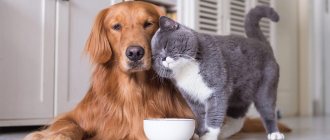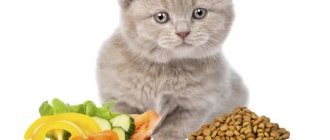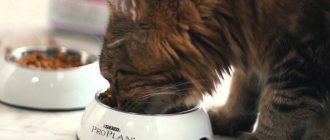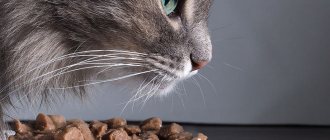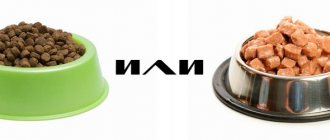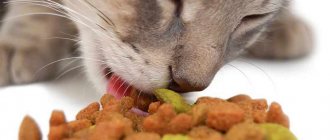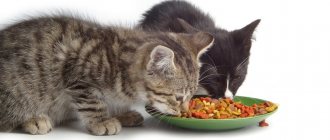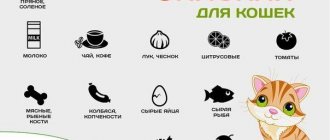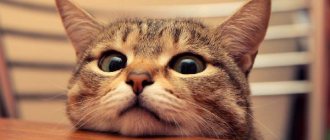Natural curiosity often leads a dog to the cat's bowl. There are cases when the owner himself gives her someone else’s food, forgetting to buy specialized food. But, despite the desire of the animal or the convenience of the owner, feeding a dog with cat food is strictly prohibited. Dog food manufacturers have long broken sales records by releasing a universal product for them. The limitation is due to several factors, primarily animals have different physiology and digestive systems.
Differences between cat and dog food
Food for completely different species of animals has a similar consistency, appearance and smell. It is the bright meat or fish aroma that attracts dogs to someone else's food. But these parameters are where the common features of the two types of feed end.
Speaking about the differences between the diets of cats and dogs, we should not forget about the structure of the digestive system of each animal. Representatives of the cat family are absolute predators. The share of animal protein in their food prevails over other components. Dogs are omnivores; along with meat, they need grains and vegetables.
High blood glucose levels in cats significantly affect the digestibility of foods. For them, small and frequent meals are a necessity. The dog does not need such a diet and it is enough to feed it 2 times a day.
The most significant differences are the following:
- in the composition of cat food, the manufacturer focuses on protein;
- Canines are recommended to regularly consume fiber;
- the required amount of animal protein for a dog is not less than 25%, cats need from 40%;
- the accelerated metabolism of cats requires more high-calorie food;
- the set of necessary minerals is also different: dogs require potassium, calcium and magnesium, cats need phosphorus more.
The compositions of the feed are similar only in the volume of fats of plant and animal origin and synthesized vitamin supplements. The listed differences are equally valid for dry food and various food bags.
Features of the diet for kittens
Veterinarians and felinologists recommend choosing expensive premium or super-premium products from well-known manufacturers.
These foods contain all the necessary ingredients for the trouble-free growth and full development of a kitten.
Some super-premium category foods have a comprehensive line of baby foods, taking into account the age, breed and physiological state of the kitten. Thus, Royal Canin offers:
- Royal Canin Mother and Babycat for kittens from 1 to 4 months. This food is excellent for babies in the 1st growth phase, has a delicate texture, absorbs moisture well and can be successfully used as a wet diet for the first feeding. Small soft granules are easily chewed by baby teeth, and the extremely rich chemical composition satisfies all the kitten's immediate needs.
- Royal Canin Kitten for kittens up to 12 months. This product is recommended for “teenagers” in the 2nd growth phase. The total caloric intake of the diet is reduced due to a decrease in fat (18%), but the percentage of protein compounds is increased due to active muscle growth (34%).
- Royal Canin British Shorthair Kitten is an excellent choice when raising British Shorthair kittens. The food is characterized by a high protein content (38%) for building powerful muscles, L-carnitine, taurine and omega-3 fatty acids for heart health, as well as chondroitin and glucosamine as chondroprotectors.
- Royal Canin Persian Kitten 32 for Persian kittens from 2 to 12 months - focuses on complete digestion of food, healthy skin and coat, and strengthening the immune system. The special formula of granules guarantees comfort while eating.
- Royal Canin Sterilized for sterilized kittens aged 6 to 12 months. Specially developed granules with a reduced fat content (12%) help reduce the risk of excess body weight gain after sterilization, and the balance of protein and minerals contributes to the harmonious completion of growth processes without undue stress on the excretory system.
Other recommended brands. In addition to the above products, a good choice for kittens would be:
- Orijen Cat & Kitten;
- Acana (kitten range);
- Pronature Original Kitten;
- Bosch Sanabelle Kitten.
Ban on economy category. Economy class food is attractive due to its low price, but is made from low-quality raw materials, contains a limited list of ingredients, and, in addition, is saturated with cheap dyes, flavors and preservatives, and therefore is strictly prohibited for feeding growing offspring.
Why does a dog eat cat food?
There are several reasons for this interest. One of the most common is an attractive smell. It is a rare dog that can resist aromatic and flavoring additives combined with a high content of animal protein. Most often, low-price foods have an intense smell, and they are equally harmful to both animals.
A pet’s persistent desire to eat the neighbor’s food may indicate a lack of protein in its own diet. In this case, it is worth reconsidering the choice of food for your four-legged friend.
Common reasons for attacks on a cat's bowl include:
- food aggression and attempts to establish a dominant position in the house;
- tasteless, cold or poorly prepared food;
- lack of sufficient meat in the diet;
- constant open access to food;
- curiosity and desire to try new products.
Attempts to seize someone else's food are often made by very young animals. In this way, the dog can play with other pets or demand attention. It is also possible that the puppy quickly ate his portion and switched to cat food. A single use will not harm him in any way, but in the future such actions must be stopped.
This is interesting: Peculiarities of feeding dogs at different periods of life
May or may not be given
Cat food contains more calories and protein than a dog that lives in an apartment and doesn’t move much needs. Some veterinarians recommend a cat diet for malnourished animals. The pet will quickly gain the missing pounds, but when experimental feeding continues for 2 weeks or more, health risks arise.
Feeding wet cat food makes the situation worse: canned food tastes better than kibble. Begging develops, the dog terrorizes the household, and when its whims are satisfied, it becomes impudent and tries to steal food from the table. The risk of mental illness in the animal increases.
If a dog eats cat food once, nothing bad will happen to him. You cannot constantly give your dog ready-made cat food: it is dangerous to health.
The dangers of cat food for dogs
Stealing someone else's food not only harms smaller pets, but also causes damage to the offender's body. The composition and ratio of ingredients is selected in a special way and is suitable only for a certain type of animal. Regular use will cause serious consequences, including chronic diseases.
- Obesity. Physical activity and a faster metabolism help cats stay lean. It is important for them to have constant access to food, as they eat small portions. The dog digests food much more slowly, so the calorie content of the food should be lower. Otherwise, the risk of becoming overweight increases. This problem especially concerns castrated and sterilized animals.
- Allergy. Cat food contains taurine, gluten and some types of starch. If a dog eats cat food on a regular basis, it may develop a cross-allergy to completely harmless products. Among the unpleasant consequences will be hair loss, irritation of the mucous membranes of the eyes and nose, and seborrhea.
Small dog breeds are especially vulnerable to allergies. For some of them, even a one-time satisfaction of curiosity can lead to shock, accompanied by suffocation and kidney failure.
- Skin diseases. Long-term consumption of unsuitable food leads to a significant deterioration in the quality of the coat. Dermatitis of various origins, scabs or eczema form on the dog’s skin. Such diseases will require not only diet, but also long, expensive treatment.
- Problems with the gastrointestinal tract. Lack of fiber in the right quantities for your dog can cause intestinal problems. Cat food has a higher degree of acidity, which is unacceptable for the canine digestive system. The volume of protein also exceeds the values suitable for the normal functioning of the stomach. As a result, the dog may develop gastritis.
- Heart diseases. The presence of taurine and a vitamin complex unsuitable for dogs leads to a deterioration in heart function. This fact directly affects the life expectancy of the pet. Giving dogs food that is not intended for them is indeed very harmful.
- Kidney and liver failure. An increased concentration of animal protein leads to malfunctions of the pancreas and other internal organs. The specific composition can provoke the formation of stones in the bile ducts and kidneys of the dog.
In addition to the listed diseases, curiosity and the desire to try someone else's food can cause otitis media and conjunctivitis.
What changes after sterilization/castration
The operation leads to changes in hormonal levels in cats. In females, the production of estrogens, hormones responsible for sexual desire, fertilization and saturation with food, stops. For this reason, the animal begins to overeat, which leads to obesity, diabetes, urolithiasis (KD), and heart problems.
In sterilized cats, due to the removal of the gonads, testosterone disappears, which manifests itself in a decrease in sexual desire and deterioration in the absorption of nutrients. If you do not pay attention to proper nutrition, the animal will quickly gain weight after surgery, and it will have an increased risk of developing cystitis, diabetes, and kidney problems.
Important
:
The sterilization procedure itself does not harm the animal, rather the opposite. The risk of cancer is reduced, the pet becomes calmer, and is not tormented by hormonal surges. BUT sterilization requires a revision of the diet. If this is not taken into account, problems may arise.
How to stop a dog from eating cat food
A dog may persistently demand a forbidden treat for a long time. In some cases, she refuses to eat and shows her indignation in every possible way. The owner’s task is not to be led by pity and strictly adhere to the following recommendations:
- feed animals separately from each other;
- remove cat food out of reach of the dog;
- maintain a daily routine, especially in matters of nutrition;
- exclude all harmful foods from the diet;
- increase physical activity and walks in the fresh air;
- when using industrial feed, give preference to quality products;
- natural porridges must be prepared daily; stale food can provoke a desire to take the cat away.
Useful article: Puppy feeding schedule by month
The right decision would be to visit a veterinarian. This will help rule out factors associated with undiagnosed diseases and assess the dog's condition.
Expert opinion
Anna Abramenko
An avid dog lover. Experience in veterinary medicine since 2009.
Ask a Question
You should not suddenly change your pet’s food if he is used to eating cat food. This will lead to justified grievances and refusal to eat. The content of the prohibited product should be gradually reduced by mixing it with high-quality dog food.
Rules for choosing dog food
Regardless of the type of food, the composition must contain the optimal set of ingredients. Manufacturers of high-quality dog food take into account all factors and produce products for each group of animals. The main selection criteria include the following points:
- size and weight of the dog;
- the age of the pet, puppies and elderly individuals need different components;
- level of physical activity;
- diet of pregnant and lactating bitches;
- differences in products by breed.
Inconsistency between the type of food and the characteristics of a particular dog will lead to an imbalance of vitamins and minerals. In addition to the listed criteria, it is necessary to take into account the condition of the pet. A sick dog requires a change in diet to speed up the recovery of the body. There are also dietary and hypoallergenic foods.
A dog's desire to try something new often seems like a harmless prank to its owners. Of course, eating cat food once will not cause irreparable harm. But a dog should not constantly eat food that is not suitable for its composition. A properly selected diet is considered the key to a pet’s good health and long life.
Feeding tips
In order for the cat to receive from food all the microelements necessary for the cat’s body, it is necessary to correctly compose the daily diet. The pet's menu must contain 75% meat (beef, veal), 25% vegetables (cabbage, beets, broccoli, pumpkin) and cereals. Any meat must first be processed to prevent parasitic diseases. It is allowed to give fermented milk products - cottage cheese, kefir, yoghurts.
When preparing the correct diet, you should take into account the age of the pet and the characteristics of its lifestyle. Excess protein can provoke urolithiasis, carbohydrates, fat - obesity and diabetes. If a cat prefers to eat dog food, this means that its food needs to be replaced. Ignoring this behavior can provoke heart disease, gastrointestinal pathologies, diseases of the nervous or circulatory system. In some cases, regularly eating dry dog food can lead a cat to blindness, cancer or infertility.
